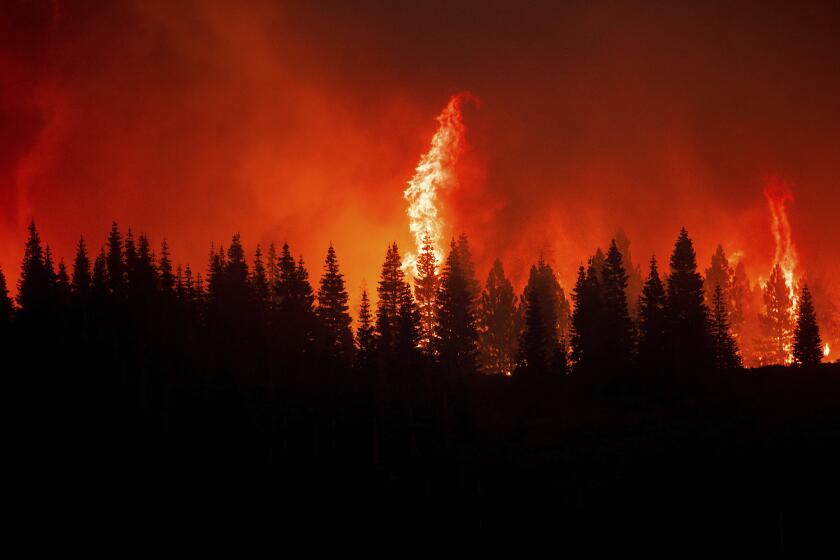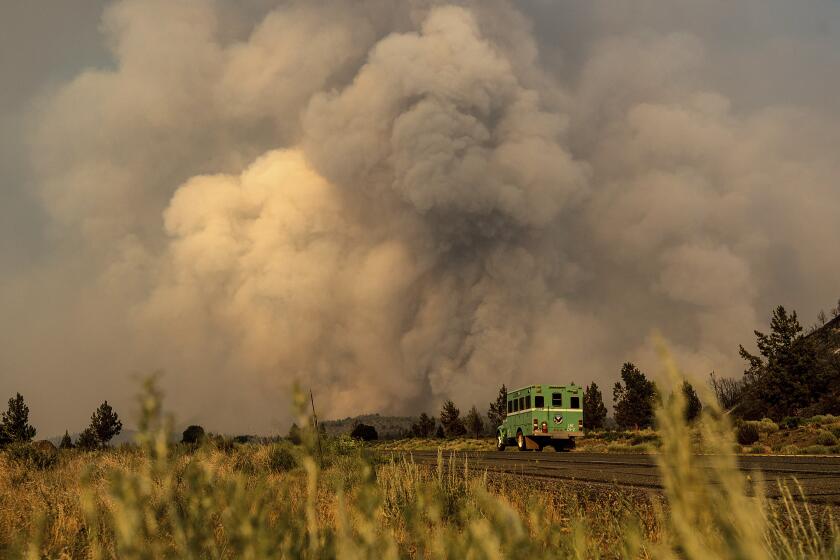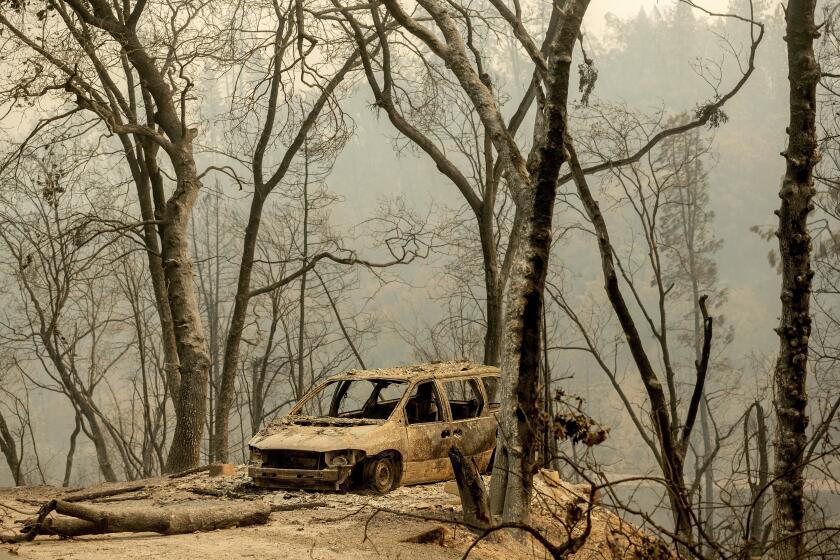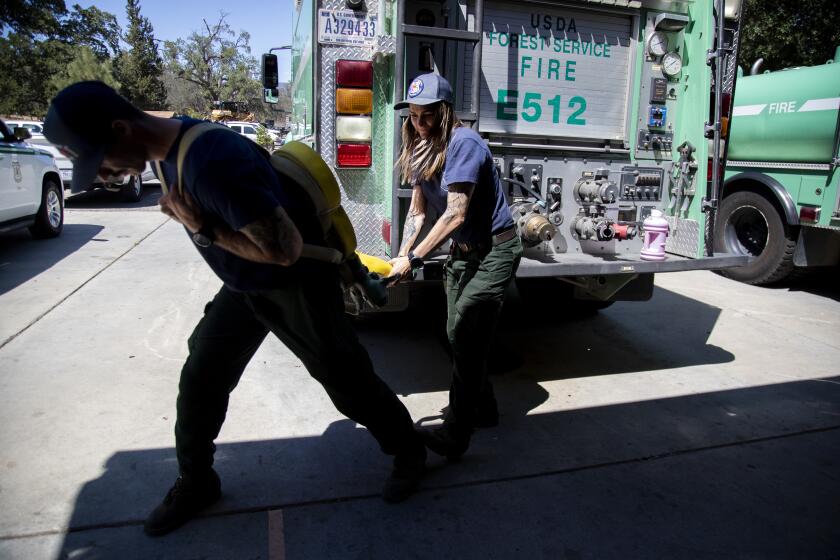California hit by record-breaking fire destruction: ‘Climate change is real, it’s bad’
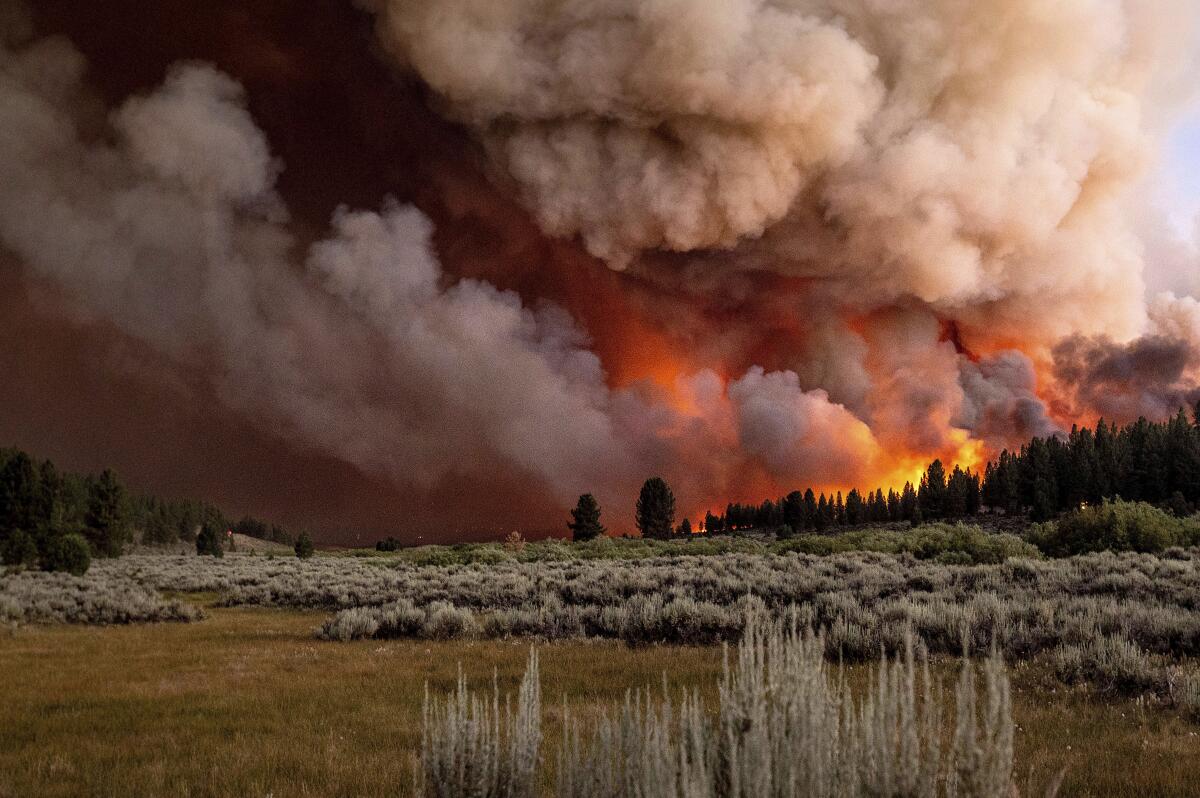
- Share via
California is off to another record-breaking year of wildfires as the state enters its most dangerous months, with extreme heat and dry terrain creating the conditions for rapid spread.
More than twice as many acres burned in the first six months of this year than during the same period last year — and hundreds more fires, officials said.
June saw a series of destructive blazes that swept through rural counties at the northern edge of the state, fueled by a historic Pacific Northwest heat wave. But July is already shaping up to be worse.
The Sugar fire had spread to 83,256 acres as of Sunday, making it the largest so far this year in California. Flames swept into the small town of Doyle, destroying homes and other structures. Sparked by lightning in the Plumas National Forest, it forced 3,000 to flee their homes in Plumas and Lassen counties.
Already this year, there have been more than twice as many acres burned than during the same period last year — and hundreds more fires.
The news comes after months of concerning forecasts and warnings about what the 2021 wildfire season may bring. Officials said the increased activity is being driven by hot, dry conditions that have plagued much of the West Coast for weeks, while scientists noted that shifting jet streams and the state’s unique topography are also contributing to the earlier and more frequent conflagrations.
One thing everyone agrees on is that climate change is a factor that cannot be ignored.
“The exceptional fire weather this year and in recent years does not represent random bad luck,” said Jacob Bendix, a Syracuse University professor who specializes in pyrogeography, or the study of wildfire distribution. “It is among the results of our adding carbon to the atmosphere — results that were predictable, and indeed that have been predicted for decades.”
‘This fire stayed very small,’ said Adrienne Freeman, spokeswoman for the Shasta-Trinity National Forest about the Lava fire. ‘Until it didn’t.’
About 4,600 fires scorched 74,000 acres across the parched state between Jan. 1 and July 4, compared with roughly 3,800 fires and 31,000 acres during the same time in 2020, the California Department of Forestry and Fire Protection said. Those numbers do not include losses from fires over the last week.
Though last year was the worst wildfire season California has seen — with over 4 million acres burned — the potential to surpass it is there, said Cal Fire spokeswoman Lynne Tolmachoff.
“We just kind of have to wait and see what Mother Nature does,” she said.
Historically, September and October are the worst months for large, devastating wildfires, Tolmachoff said, “and we haven’t even reached those months. We’ve still got time to go with more hot weather and dry weather, and we won’t see significant rain for months.”
The drought conditions are so bad that Gov. Gavin Newsom on Thursday asked Californians to voluntarily cut back on water consumption by 15%.
Not only is there little water on the horizon, but the alarmingly low rain levels over the last year have already had a devastating effect on California’s landscape. Lack of snowpack is contributing to more fires at higher elevations, Tolmachoff said, while large swaths of vegetation statewide are primed and ready to ignite.
“A lot of it goes back to the fact that the rain stopped, basically,” she said. “Everything out there is already dead, and the more heat you put on it, especially during the peak heat of the day, the smallest things can cause a wildfire.”
That dryness is what has enabled some of the state’s recent blazes, such as the Salt fire to spread so quickly and cause so much destruction. It has already burned through more than 12,600 acres and destroyed more than two dozen homes. As of Sunday afternoon, the fire was 70% contained.
Authorities announced Saturday that the Salt fire had destroyed at least 27 homes and 14 outbuildings.
In fact, the state’s most flammable fuels, including the grasses that line countless hillsides, cured way earlier than usual this year, said Craig Clements, a professor of meteorology and director of the Wildfire Interdisciplinary Research Center at San Jose State.
Landscapes that are typically green through June were brown by mid-April, he said, and red flag warnings abounded last month when typically there are few.
“People need to be aware that we are in a drought and that our fuels are critically low,” Clements said. “No matter what, we are in this heightened risk throughout the state.”
And record-smashing heat waves are further contributing to the danger by drying the state’s vegetation like an oven, Clements said.
In Southern California, all three of the National Weather Service’s desert climate sites — Palm Springs, Thermal and Anza-Borrego — experienced their hottest June on record this year, “and it wasn’t a close call,” the agency said last week. Palm Springs saw a mean June temperature 5.3 degrees above normal.
Clements said climate change is also causing Earth’s jet streams to change their typical patterns, creating a discontinuity between Arctic and tropical air that is contributing to extreme weather events like the recent heat dome that simmered over the Pacific Northwest. One study found that that deadly heat wave would have been virtually impossible without human-caused climate change adding a few extra degrees.
“Climate change is real, it’s bad and it’s really affecting our fire weather and our fire danger,” Clements said. “Its fingerprints are all over this stuff.”
However, Clements said, wildfires are also “day-to-day,” which means that they are highly dependent on conditions in a given moment — from heat to wind to dryness. Many of those factors, when combined with California’s particular topography, make the state especially prone to burning.
“We have mountains, we have all sorts of different fire-adapted or fire-prone ecosystems and we have lots of people living in the state,” he said, adding that California also has a lot of unique shrub lands and offshore wind events. “We just are the fire state.”
Crews facing some of the state’s wildfires have described how California’s steep canyons and rocky ridges can act like chutes for the wind, fanning the flames as if in a funnel.
“Very warm temperatures and south winds kind of lined up with the terrain and the vegetation,” Sugar fire spokeswoman Phyllis Ashmead said last week, “so it’s just very primed for fire.”
Crews battling that 83,256-acre fire were set back substantially at one point after a wind-whipped ember jumped containment lines and ignited a new blaze. As of Sunday afternoon, the Sugar fire was only 8% contained.
And the extreme fire events are growing increasingly dramatic. At the 10,500-acre Tennant fire in Klamath National Forest, near the Oregon border, the U.S. Forest Service captured video of a “fire whirl,” or a “spinning vortex column of ascending hot air and gases rising from a fire.”
In the video, thick black smoke quickly gathers and spins near burning flames, almost completely obscuring a rescue truck in the distance. That fire was 95% contained Sunday afternoon.
Firefighters with the U.S. Forest Service say factors like heat, drought and population growth are changing the way they fight fire.
Forest management can also be a factor in the state’s combustibility, multiple experts said, as decades of wildfire suppression have simultaneously protected communities and enabled dry vegetation to pile up on forest floors. Even recent bark beetle infestations have contributed to the fiery conditions, as they prey on damaged trees and dry vegetation.
And nearly all of it can be linked back to the changing climate, Tolmachoff said.
“Whatever the cause of climate change is at this point, it’s happening and it’s making a difference here in the state,” she said.
And even as crews turn a corner on some of Northern California’s blazes, much of the southern part of the state is bracing for enhanced fire weather conditions, including triple-digit temperatures and substantially low levels of humidity that will seep into the coming week.
Already on Friday, a brush fire ignited in Tuna Canyon near Malibu. It grew to 6 acres by midmorning before crews gained control over the flames amid challenging terrain.
As to whether 2021 will surpass last year’s terrible numbers, it’s too soon to tell — particularly since one of the biggest factors in 2020’s record-breaking season was the dry lightning storm that sparked some of California’s biggest infernos.
If something like that happens again, it is certainly possible that this year will be worse than the last, experts said.
Times staff writer Alex Wigglesworth contributed to this report.
More to Read
Sign up for Essential California
The most important California stories and recommendations in your inbox every morning.
You may occasionally receive promotional content from the Los Angeles Times.
